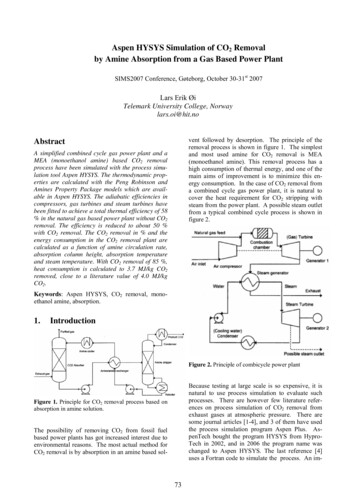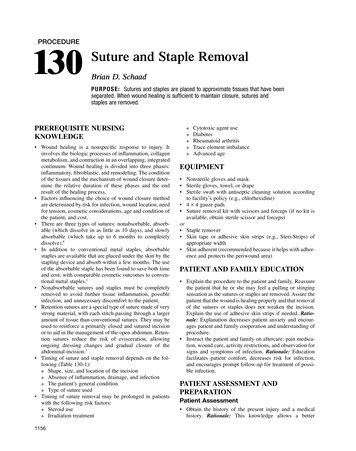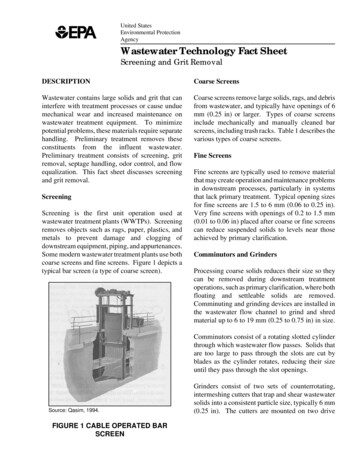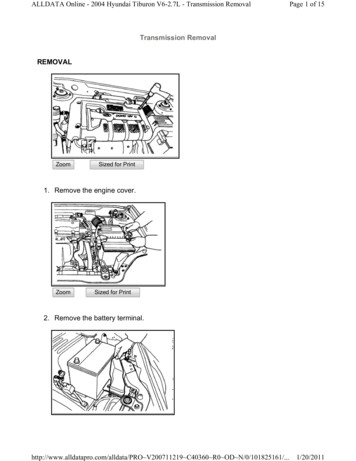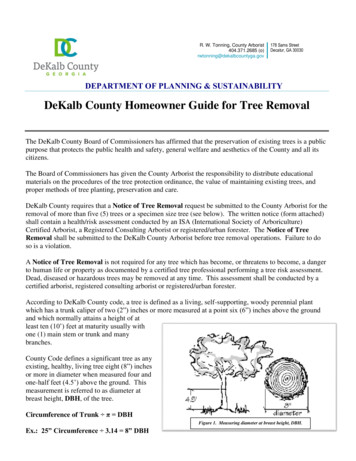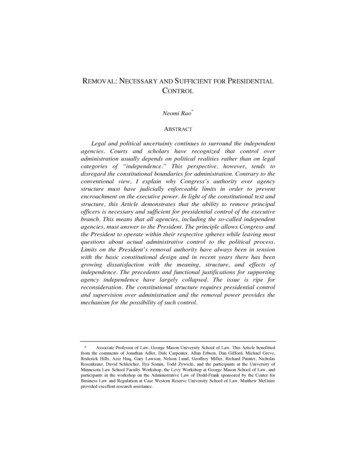
Transcription
RAO FINAL (DO NOT DELETE)7/17/2014 5:00 PMREMOVAL: NECESSARY AND SUFFICIENT FOR PRESIDENTIALCONTROLNeomi Rao*ABSTRACTLegal and political uncertainty continues to surround the independentagencies. Courts and scholars have recognized that control overadministration usually depends on political realities rather than on legalcategories of “independence.” This perspective, however, tends todisregard the constitutional boundaries for administration. Contrary to theconventional view, I explain why Congress’s authority over agencystructure must have judicially enforceable limits in order to preventencroachment on the executive power. In light of the constitutional text andstructure, this Article demonstrates that the ability to remove principalofficers is necessary and sufficient for presidential control of the executivebranch. This means that all agencies, including the so-called independentagencies, must answer to the President. The principle allows Congress andthe President to operate within their respective spheres while leaving mostquestions about actual administrative control to the political process.Limits on the President’s removal authority have always been in tensionwith the basic constitutional design and in recent years there has beengrowing dissatisfaction with the meaning, structure, and effects ofindependence. The precedents and functional justifications for supportingagency independence have largely collapsed. The issue is ripe forreconsideration. The constitutional structure requires presidential controland supervision over administration and the removal power provides themechanism for the possibility of such control.*Associate Professor of Law, George Mason University School of Law. This Article benefittedfrom the comments of Jonathan Adler, Dale Carpenter, Allan Erbsen, Dan Gifford, Michael Greve,Roderick Hills, Aziz Huq, Gary Lawson, Nelson Lund, Geoffrey Miller, Richard Painter, NicholasRosenkranz, David Schleicher, Ilya Somin, Todd Zywicki, and the participants at the University ofMinnesota Law School Faculty Workshop, the Levy Workshop at George Mason School of Law, andparticipants in the workshop on the Administrative Law of Dodd-Frank sponsored by the Center forBusiness Law and Regulation at Case Western Reserve University School of Law. Matthew McGuireprovided excellent research assistance.
RAO FINAL (DO NOT DELETE)12067/17/2014 5:00 PMAlabama Law Review[Vol. 65:5:1205INTRODUCTION . 1207I. CONTROL OVER EXECUTION AND THE PRESIDENT’S DIRECTIVEAUTHORITY. 1212A. The Constitutional Framework for Control . 1212B. Executive Power Includes Directive Authority . 1217C. The President Is More Than an “Overseer”. 1219II. REMOVAL NECESSARY AND SUFFICIENT FOR PRESIDENTIALCONTROL . 1225A. Necessity of the Removal Power . 1227B. The Conventional View of “Independence” Is Ripe forReconsideration . 1230C. Executive Power Does Not Include Additional Mechanismsof Control. 1234D. Removal Is Constitutionally Sufficient . 1241III. APPLICATIONS AND CONSEQUENCES OF RULE OF REMOVAL ATWILL . 1243A. Necessity of Removal . 12431. Principal Officers Must Be Removable at Will . 12442. Inferior Officers . 12443. Adjudicators . 12474. Interpreting Good Cause . 1250B. Sufficiency: Congress Retains Wide Authority over AgencyStructure and Assignment of Duties . 12511. Multi-Member Commissions or Boards . 12512. Appointment for a Term of Years . 12523. Independent Budgeting Sources. 12534. Separate Litigating Authority . 12535. Legislative Powers of Control . 1254IV. ENFORCEABILITY AND OTHER BENEFITS . 1257A. Removal Provides an Enforceable Rule for PresidentialControl. 1257B. Severance: A Minimal Remedy . 1261C. Clearing the Fog of Independence . 1264D. Benefits to Administration . 1266V. CASE STUDY: PRESIDENT, CONGRESS, AND THE CFPB . 1269A. Challenges to the Bureau . 1270B. Removal Provides the Constitutional Remedy . 1271C. Removal May Provide Only Limited Control . 1274CONCLUSION . 1275
RAO FINAL (DO NOT DELETE)2014]7/17/2014 5:00 PMRemoval: Necessary and Sufficient1207INTRODUCTIONDoes the Consumer Financial Protection Bureau (“CFPB”) violateseparation of powers? Since its establishment, the CFPB has facedpolitical, administrative, and constitutional attacks.1 Critics have chargedthat the Bureau possesses sweeping regulatory authority combined with anunprecedented degree of independence. The Dodd-Frank Act establishesthis “independent bureau”2 and specifies that the President can remove itsdirector only “for inefficiency, neglect of duty, or malfeasance in office.”3Moreover, the Bureau draws its budget from a fund within the FederalReserve outside of Congress’s appropriations process.4 The statute alsoinsulates the Bureau from review and control by the President and theOffice of Management and Budget.5 Several lawsuits have alleged that theBureau’s combination of features violates separation of powers.6The constitutionality of this “independent bureau” implicates a broaderdebate about the extent to which the President must control the executionof the laws and the degree of independence that Congress can establish foradministrative agencies. Although numerous so-called independentagencies7 exist in the federal government, challenges to theirconstitutionality continue to arise. This Article aims to identify theconstitutional minimum for the exercise of presidential control over1.See, e.g., U.S. CHAMBER OF COMMERCE, U.S. HOUSE SUBCOMMITTEE ON TARP, FINANCIALSERVICES, AND BAILOUTS OF PUBLIC AND PRIVATE PROGRAMS, (May 24, 2011), available “I am not aware of any other federal agency charged with regulating private sector activity thatpossesses all of these features. It is a dangerous combination, rendering the CFPB virtually immunefrom the well-established checks and balances that traditionally have been relied upon to guide andconstrain agency action.”).2.The Dodd-Frank Act establishes within the Federal Reserve “an independent bureau . . . whichshall regulate the offering and provision of consumer financial products or services under the Federalconsumer financial laws.” 12 U.S.C. § 5491(a) (2012).3.12 U.S.C. § 5491(c)(3).4.12 U.S.C. § 5497(a)(1) (providing that the Federal Reserve “shall transfer to the Bureau fromthe combined earnings of the Federal Reserve System, the amount determined by the Director to bereasonably necessary to carry out” the CFPB’s functions); see also 12 U.S.C. § 5497(a)(2) (setting fortha cap for transfers to the CFPB).5.12 U.S.C. § 5492(c)(4) (“No officer or agency of the United States shall have any authority torequire the Director or any other officer of the Bureau to submit legislative recommendations, ortestimony or comments on legislation, to any officer or agency of the United States for approval,comments, or review prior to the submission of such recommendations, testimony, or comments to theCongress . . . .”).6.Several banks brought suit, represented by former White House Counsel C. Boydon Gray andthe Competitive Enterprise Institute. See Brief for Plaintiffs, State Nat’l Bank of Big Spring v. Lew, 958F.Supp.2d 127 (D.D.C. Aug. 1, 2013) (Case No. 1:12-cv-01032).7.This Article challenges the idea that there can be agencies “independent” of the President andargues that all of the quasi-legislative and quasi-judicial agencies treated as independent are properlyunderstood as executive branch agencies. See infra notes 109–116 and accompanying text. Nonetheless,for ease of discussion, I refer to independent agencies to denote the agencies conventionally understoodin this way.
RAO FINAL (DO NOT DELETE)12087/17/2014 5:00 PMAlabama Law Review[Vol. 65:5:1205administrative agencies. In light of the constitutional text and structure, Idemonstrate that the ability to remove at will all principal officers is bothnecessary and sufficient to ensure presidential control. The full removalpower establishes a chain of command between the President and hissubordinates that allows the President to direct in whatever way hechooses.This inquiry is timely because contemporary developments suggestreasons for reconsidering the conventional status of independent agencies.For instance, the Supreme Court has repeatedly recognized that allagencies, including the independent ones, are part of the executive branch,8making it difficult to explain as a constitutional matter why they should notbe under the control and supervision of the Chief Executive. In addition,the Supreme Court’s decision in Free Enterprise Fund v. Public Co.Accounting Oversight Board9 could be read to undermine theconstitutionality of any removal restriction that prevents the President fromcontrolling or supervising execution of the laws.10Moreover, recent scholarship has sought to clarify what preciselyfollows from the for-cause removal restrictions that are the hallmark ofindependent agencies.11 Uncertainty remains about how precisely thePresident can supervise these agencies.12 An emerging understandingrecognizes that not much turns on removal or current labels of“independence.” Yet this recognition is often accompanied by a disinterestin constitutional standards or acceptance of virtually unlimitedcongressional authority to impose limits on presidential control.13 Others8.See infra notes 103–109 and accompanying text.9.130 S. Ct. 3138, 3163 (2010) (holding two layers of removal restrictions unconstitutionalbecause they impermissibly limit the President’s exercise of the executive power and his control ofexecutive officers).10.I advance this argument in greater detail elsewhere. See Neomi Rao, A Modest Proposal:Abolishing Agency Independence in Free Enterprise Fund v. PCAOB, 79 FORDHAM L. REV. 2541, 2544(2011) (explaining why the “Court’s logic can lead to the conclusion that even one layer of for-causeremoval protection is unconstitutional” and that its arguments can be applied “to the wider battle overagency independence”); see also In re Aiken Cnty., 645 F.3d 428, 439–46 (D.C. Cir. 2011)(Kavanaugh, J., concurring) (arguing that Free Enterprise Fund undermines the constitutionality of allindependent agencies that operate “free of presidential direction and supervision”).11.See Kirti Datla & Richard L. Revesz, Deconstructing Independent Agencies (and ExecutiveAgencies), 98 CORNELL L. REV. 769 (2013); Adrian Vermeule, Conventions of Agency Independence,113 COLUM. L. REV. 1163, 1203 (2013); Lisa Schultz Bressman & Robert B. Thompson, The Future ofAgency Independence, 63 VAND. L. REV. 599 (2010); Elena Kagan, Presidential Administration, 114HARV. L. REV. 2245, 2327 (2001); Lawrence Lessig & Cass R. Sunstein, The President and theAdministration, 94 COLUM. L. REV. 1, 103 (1994).12.Aziz Z. Huq, Removal as a Political Question, 65 STAN. L. REV. 1, 5–6 (2013); see also Datla& Revesz, supra note 11; Peter L. Strauss, The Place of Agencies in Government: Separation of Powersand the Fourth Branch, 84 COLUM. L. REV. 573, 594 (1984).13.See Datla & Revesz, supra note 11, at 775, 839 (noting that the President can require allagencies to submit to OIRA review “because there is no statutory bar prohibiting them from doing so,”but that Congress can “exempt agencies from the regulatory review requirement”); Kagan, supra note
RAO FINAL (DO NOT DELETE)2014]7/17/2014 5:00 PMRemoval: Necessary and Sufficient1209have argued that agency structures should be left to the political processand constitutional challenges treated as political questions inappropriate forjudicial review.14 Scholars focusing on realist insights about independencehave generally proposed functional solutions and remained relativelyindifferent to constitutional requirements.By contrast, I explain why a realistic understanding of administrationlends greater urgency to constitutional questions and supports a formalframework of removal as necessary and sufficient for presidential control.The argument proceeds primarily from the text and structure of theConstitution.15 In particular, I do not provide an originalist or historicaldefense of this principle.16 Even with historical background about themeaning of presidential and congressional powers with respect toadministration, scholars must still draw logical inferences for how theseconstitutional powers interact.17 Despite expansion of the administrativestate, Congress’s authority over agency structure must have some limits.Presidential control cannot be left to statutory interpretation or politics. Therecognition that “independence” has an uncertain and unpredictableconnection to presidential control and that administration depends largely11, at 2325–26 (assuming that statutory assignments do not limit presidential direction unless Congressclearly indicates such a limit); Lessig & Sunstein, supra note 11, at 112 (explaining that “courts wouldallow the President [broad supervisory] power unless Congress has expressly stated its will to thecontrary”).14.Huq, supra note 12, at 5–6.15.See generally CHARLES L. BLACK, STRUCTURE AND RELATIONSHIP IN CONSTITUTIONAL LAW31 (1969) (“There is . . . a close and perpetual interworking between the textual and the relational andstructural modes of reasoning, for the structure and relations concerned are themselves created by thetext, and inference drawn from them must surely be controlled by the text.”); John F. Manning,Separation of Powers as Ordinary Interpretation, 124 HARV. L. REV. 1939, 1947–49 (2011)(explaining that there is “no freestanding separation of powers doctrine” but that structuralconstitutional provisions can be understood “through clause-centered methods of textualinterpretation”).16.A number of scholars on both sides of this debate have marshaled impressive historicalstudies of this topic and reached competing conclusions. Compare STEVEN G. CALABRESI &CHRISTOPHER S. YOO, THE UNITARY EXECUTIVE: PRESIDENTIAL POWER FROM WASHINGTON TO BUSH(2008); Steven G. Calabresi & Saikrishna B. Prakash, The President’s Power to Execute the Laws, 104YALE L.J. 541, 592 (1994); Steven G. Calabresi & Kevin H. Rhodes, The Structural Constitution:Unitary Executive, Plural Judiciary, 105 HARV. L. REV. 1153, 1167 (1992), with Martin S. Flaherty,The Most Dangerous Branch, 105 YALE L.J. 1725, 1729 (1996) (utilizing a historical approach basedon primary materials as well as historical scholarship in order to “expose[] the presidentialist account—advanced in its most powerful form by Justice Scalia and Professors Stephen Calabresi and SaikrishnaPrakash—as incomplete and flawed”); Lessig & Sunstein, supra note 11, at 4.17.See Calabresi & Rhodes, supra note 16, at 1167 (“Although unitary executive theoristsbelieve that Article II gives the President broad powers of control over the executive department, theymust concede that both the text of Article II and our historical practice are of little help in identifyingwhich of these mechanisms of presidential control, if any, is correct.”); Flaherty, supra note 16, at 1816(explaining changed circumstances in the federal government and arguing that “the task of fidelitydemands figuring out what current applications best serve the Founding’s surviving purposes in thisnew world”); see also H. Jefferson Powell, Rules for Originalists, 73 VA. L. REV. 659, 662, 691 (1987)(“History itself will not prove anything nonhistorical” and “never obviates the necessity of choice”).
RAO FINAL (DO NOT DELETE)12107/17/2014 5:00 PMAlabama Law Review[Vol. 65:5:1205on political factors makes it all the more important to revisit theconstitutional framework of administration and to establish the boundariesfor presidential control.I develop the argument of the Article as follows. Part I begins byexamining the constitutional framework for control and specificallydemonstrating why the executive power includes directive authority overall federal agencies. The President must be able to direct an officer in theexercise of a discretionary duty assigned to that officer by law. I explainwhy the account of the President as “overseer”18 claims too much forCongress’s authority and fails to provide a workable legal standard forexecution.In Part II, I demonstrate the central claim that removal provides thenecessary and sufficient constitutional mechanism for ensuring presidentialcontrol and the possibility of direction. Removal properly places executiveofficers within the President’s chain of command. Given that so manyaspects of actual presidential control are imperceptible, political, anddiscretionary, the President has constitutionally sufficient control when hecan remove all principal executive branch officers, including the heads ofthe so-called independent agencies. Seeking a rule that avoidsencroachments on core legislative powers, I explain why the only requiredmechanism for enforcing control is the removal power.19Part III develops some of the consequences of the rule of removal asnecessary and sufficient, examining how it would affect the power of thePresident over various types of officers. The sufficiency of removal leavesCongress free to promote various administrative values through the use ofagency structures, including multi-member commissions or boards;appointment of officers for a term of years; independent budgetingresources; and separate litigating authority.20 Congress retains wide latitude18.See Peter L. Strauss, Overseer, or “The Decider”? The President in Administrative Law, 75GEO. WASH. L. REV. 696, 704 (2007); see also Heidi Kitrosser, The Accountable Executive, 93 MINN.L. REV. 1741 (2009); Robert V. Percival, Presidential Management of the Administrative State: TheNot-So-Unitary Executive, 51 DUKE L.J. 963, 1011 (2001); Kevin M. Stack, The President’s StatutoryPowers to Administer the Laws, 106 COLUM. L. REV. 263, 295 (2006).19.Accordingly, I disagree with unitary theorists who have argued that presidential control mustalso include the ability to act in the place of a subordinate and to nullify actions of subordinates. Theseadditional forms of control claim too much for the President and render meaningless Congress’s abilityto assign statutory duties to other officers. See Calabresi & Prakash, supra note 16, at 599 (“[T]hePresident must be able to control subordinate executive officers through the mechanisms of removal,nullification, and execution of the discretion ‘assigned’ to them himself.”); Calabresi & Rhodes, supranote 16, at 1166; Gary Lawson, The Rise and Rise of the Administrative State, 107 HARV. L. REV. 1231,1243 (1994) (explaining why the President must have the power of nullification, but not necessarily thepower of removal or the authority to act in the place of a subordinate).20.There may be other limits on Congress’s ability to structure agencies, for example limitsstemming from the President’s authority under the Appointments Clause. See infra notes 206–209 andaccompanying text. These limits are outside the scope of this Article, which focuses on thepolicymaking stage of presidential control, as opposed to the stage of institutional design when
RAO FINAL (DO NOT DELETE)2014]7/17/2014 5:00 PMRemoval: Necessary and Sufficient1211to establish administrative agencies and create regulatory duties, and thePresident, armed with the removal power, can control and direct theexecution of those laws as he sees fit. As a practical matter, a principle ofremoval as necessary and sufficient will leave many questions about actualpresidential control to the political process, where the constitutionalstructure fairly leaves it.Although the argument for removal as necessary and sufficient rests onstructural constitutional grounds, Part IV considers some advantages to theprinciple, including that it provides a judicially manageable constitutionalstandard for presidential control and for deciding separation of powerschallenges to agency independence. Removal also has a number of benefitsfor administration, including that it resolves lingering uncertainty about theconstitutionality of independent agencies and promotes a kind of politicalaccountability through the possibility of presidential control. Finally, PartV considers the constitutional challenges to the CFPB as a case study forexamining how a rule of removal as necessary and sufficient would work inpractice.Removal as necessary and sufficient properly accommodates thepowers of Congress and the President over administration. An unfetteredremoval power protects the President’s authority to control the execution ofthe laws while leaving significant scope for Congress to structure agencies.It fits with the constitutional structure, which gives each branch exclusiveauthority within its own sphere but limits encroachments.21 Removal asnecessary and sufficient also allows courts to play a role in maintainingseparation of powers while accommodating the variety of administrativeagencies that have sprung up since the New Deal. Eliminating removallimits would disentangle legal and political questions about independencethat have created administrative uncertainty. Control over administrationcould then be fought, as it usually is, on political grounds.lawmakers are proposing and designing agency structures. See Matthew C. Stephenson, OptimalPolitical Control of the Bureaucracy, 107 MICH. L. REV. 53, 66 (2008) (dividing up bureaucraticdecisionmaking into an “institutional design stage” and a “policymaking stage”). Of course, both stagesare relevant to presidential control over administration; yet here I consider only the distinct issues andpowers relevant to the policymaking stage.21.See generally THE FEDERALIST NO. 51 (James Madison) (“[T]he great security against agradual concentration of the several powers in the same department, consists in giving to those whoadminister each department the necessary constitutional means and personal motives to resistencroachments of the others . . . . Ambition must be made to counteract ambition. The interest of theman must be connected with the constitutional rights of the place.”).
RAO FINAL (DO NOT DELETE)12127/17/2014 5:00 PMAlabama Law Review[Vol. 65:5:1205I. CONTROL OVER EXECUTION AND THE PRESIDENT’S DIRECTIVEAUTHORITYThis Part uses the text and structure of the Constitution to examinesome of the essential requirements of presidential control overadministration. I propose a framework that accommodates the powers ofboth the President and Congress and use it to examine the debates over theextent of the President’s directive authority. The question of directiveauthority stands at the boundary between presidential and congressionalcontrol over administration—when Congress, by statute, assigns an officera specific duty, can the President tell the officer how to do his job? I arguethat the respective authorities of the President and Congress require that thePresident be able to direct all principal executive branch officers, evenwhen those subordinates have been assigned specific duties. Moreover, Idemonstrate why limiting the President to an “overseer” role gives toomuch authority to Congress over execution and proves functionallyunworkable.A. The Constitutional Framework for ControlIn the debate over presidential control and direction, the disagreementsoccur within a well-understood framework. Congress enjoys far-reachingauthority under the Necessary and Proper Clause “[t]o make all Lawswhich shall be necessary and proper for carrying into Execution theforegoing Powers, and all other Powers vested by this Constitution in theGovernment of the United States, or in any Department or Officerthereof.”22 Thus, Congress creates executive offices, specifies theirstructure, and assigns specific duties to executive branch officers.Similarly, there is agreement that the vesting of the executive power in thePresident, the creation of a unitary executive, requires some degree ofcontrol or oversight of the executive branch by the President.23 A proper22.U.S. CONST. art. I, § 8, cl. 18. Scholars who defend the unitary executive also recognizeCongress’s broad authority to structure executive branch agencies and the administration of law. See,e.g., Calabresi & Prakash, supra note 16, at 592 (“Although the Necessary and Proper Clause does notpermit Congress to tell the President how he ought to implement his own constitutional powers, it doesenable Congress to structure the administration of federal law.”).23.See U.S. CONST. art. II, § 3 (“[The President] shall take care that the Laws be faithfullyexecuted . . . ”). Even those who do not accept a strongly unitary executive consider that some level ofpresidential control follows from the requirements of Article II. See, e.g., Strauss, supra note 12, at 605(observing that the Founders undoubtedly created a strong unitary executive such that “congressionalarrangements that threaten the viability of an independent, unitary executive capable of opposing theCongress’s own assertions of power are, for that reason, suspect”); id. at 600 (noting the choice of aunitary executive in the Constitution and explaining that “however the executive power is defined, it isargued, it must be in ways that respect this quite fundamental structural judgment”); see also HeidiKitrosser, Accountability and Administrative Structure, 45 WILLAMETTE L. REV. 607, 616 (2009)
RAO FINAL (DO NOT DELETE)2014]7/17/2014 5:00 PMRemoval: Necessary and Sufficient1213account of presidential control must take into account both the significanceof the vesting of executive power in one President as well as the specificgrant of power to Congress under the Necessary and Proper Clause.24 Iargue here that the best understanding of the respective constitutionalpowers of Congress and the President provides for a wide measure ofpresidential control, including the ability to direct subordinates in theexercise of their discretionary statutory duties.The text and structure of Article II support a conclusion in favor ofpresidential control over administration. Article II vests all of the“executive Power . . . in a President of the United States”25 and creates astrongly unitary executive. This choice of a single executive was the resultof careful deliberation by those who created the Constitution.26 A unitaryexecutive would provide energy, encourage good administration, andensure an important form of accountability through responsibility forexecution in one person.The Vesting Clause also implies that all administrative powers that arenot exercises of the legislative and judicial powers are within the executivebranch and therefore must be within the control of the President: “Theadministrative power, if it exists, must be a subset of the President’s‘executive Power’ and not of one of the other two traditional powers ofgovernment.”27 Execution of the laws involves a wide measure ofdiscretion and that discretion must be within the control of the President,even when exercised by other officials.In addition to the Vesting Clause, other provisions of Article II clarifythe importance of this unitary structure for administration. The OpinionClause directly addresses the President’s relationship to subordinates:“[H]e may require the Opinion, in writing, of the principal Officer in eachof the executive Departments, upon any Subject relating to the Duties oftheir respective Offices.”28 As Akhil Amar has persuasively argued, thisClause is best read in light of the surrounding context and history toestablish the President as the “Chief Administrator of the ExecutiveBureaucracy.”29 The Opinion Clause allows the President to obtain an(“[W]hile Congress is not categorically required to provide for unity, it cannot remove the President sodeeply from law implementation as to functionally defeat his ability to ‘take Care that the Laws befaithfully executed.’”).24.See Henry P. Monaghan, The Protective Power of the Presidency, 93 COLUM. L. REV. 1, 23(1993) (recognizing residual powers in the President, but noting that “under no circumstances does the[residuum] argument allow any strong basis for claiming an implied grant of [executive] powersinconsistent with specific grants to other branches” (internal quotation marks omitted)).25.U.S. CONST. art. II, § 1.26.See THE FEDERALIST NO. 70 (Alexander Hamilton).27.Calabresi & Prakash, supra note 16, at 569.28.U.S. CONST. art. II, § 2, cl. 1.29.Akhil Reed Amar, Some Opinions on the Opinion Clause, 82 VA. L. REV. 647, 652
4. 12 U.S.C. § 5497(a)(1) (providing that the Federal Reserve "shall transfer to the Bureau from the combined earnings of the Federal Reserve System, the amount determined by the Director to be reasonably necessary to carry out" the CFPB's functions); see also 12 U.S.C. § 5497(a)(2) (setting forth a cap for transfers to the CFPB).

